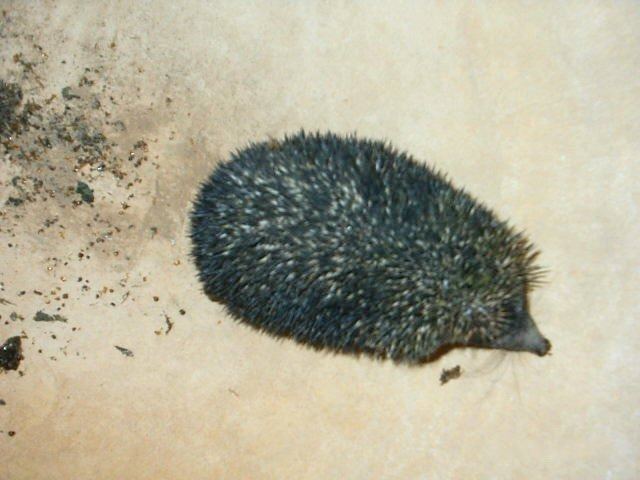This is a list of the mammal species recorded in Uzbekistan. There are 64 mammal species in Uzbekistan, of which 1 is critically endangered, 3 are endangered, 6 are vulnerable, and 4 are near-threatened.
The following tags are used to highlight each species' conservation status as assessed by the IUCN:
Some species were assessed using an earlier set of criteria. Species assessed using this system have the following instead of Near Threatened and Least Concern categories:
Rodents make up the largest order of mammals, with over 40 percent of mammalian species. They have two incisors in the upper and lower jaw which grow continually and must be keep short by gnawing. Most rodents are small though the capybara can weigh up to 45 kg (100 lb).
Suborder: Sciurognathi
Family: Sciuridae (squirrels)
Subfamily: Xerinae
Tribe: Xerini
Genus: Spermophilopsis
Long-clawed ground squirrel Spermophilopsis leptodactylus LR/lc
Tribe: Marmotini
Genus: Marmota
Long-tailed marmot Marmota caudata LR/nt
Menzbier's marmot Marmota menzbieri VU
Genus: Spermophilus
Yellow ground squirrel Spermophilus fulvus LR/lc
Little ground squirrel Spermophilus pygmaeus LR/lc
Family: Gliridae (dormice)
Subfamily: Leithiinae
Genus: Dryomys
Forest dormouse Dryomys nitedula LR/nt
Family: Dipodidae (jerboas)
Subfamily: Allactaginae
Genus: Allactaga
Great jerboa Allactaga major LR/lc
Severtzov's jerboa Allactaga severtzovi LR/lc
Vinogradov's jerboa Allactaga vinogradovi LR/lc
Genus: Allactodipus
Bobrinski's jerboa Allactodipus bobrinskii LR/lc
Subfamily: Cardiocraniinae
Genus: Salpingotus
Heptner's pygmy jerboa Salpingotus heptneri LR/nt
Subfamily: Dipodinae
Genus: Dipus
Northern three-toed jerboa Dipus sagitta LR/lc
Genus: Eremodipus
Lichtenstein's jerboa Eremodipus lichtensteini LR/lc
Genus: Jaculus
Turkmen jerboa Jaculus turcmenicus LR/lc
Genus: Paradipus
Comb-toed jerboa Paradipus ctenodactylus LR/lc
Genus: Stylodipus
Thick-tailed three-toed jerboa Stylodipus telum LR/lc
Family: Cricetidae
Subfamily: Arvicolinae
Genus: Blanfordimys
Afghan vole Blanfordimys afghanus LR/lc
Genus: Ellobius
Zaisan mole vole Ellobius tancrei LR/lc
Family: Muridae (mice, rats, voles, gerbils, hamsters, etc.)
Subfamily: Gerbillinae
Genus: Meriones
Libyan jird Meriones libycus LC
Midday jird Meriones meridianus LR/lc
Tamarisk jird Meriones tamariscinus LR/lc
Subfamily: Murinae
Genus: Nesokia
Short-tailed bandicoot rat Nesokia indica LC
The lagomorphs comprise two families, Leporidae (hares and rabbits), and Ochotonidae (pikas). Though they can resemble rodents, and were classified as a superfamily in that order until the early 20th century, they have since been considered a separate order. They differ from rodents in a number of physical characteristics, such as having four incisors in the upper jaw rather than two.
Family: Ochotonidae (pikas)
Genus: Ochotona
Turkestan red pika Ochotona rutila LR/lc
The order Erinaceomorpha contains a single family, Erinaceidae, which comprise the hedgehogs and gymnures. The hedgehogs are easily recognised by their spines while gymnures look more like large rats.
Family: Erinaceidae (hedgehogs)
Subfamily: Erinaceinae
Genus: Hemiechinus
Long-eared hedgehog Hemiechinus auritus LR/lc
Brandt's hedgehog Hemiechinus hypomelas LR/lc
The "shrew-forms" are insectivorous mammals. The shrews and solenodons closely resemble mice while the moles are stout-bodied burrowers.
Family: Soricidae (shrews)
Subfamily: Crocidurinae
Genus: Crocidura
Gueldenstaedt's shrew Crocidura gueldenstaedtii LR/lc
Lesser white-toothed shrew Crocidura suaveolens LR/lc
Genus: Diplomesodon
Piebald shrew Diplomesodon pulchellum LR/lc
Subfamily: Soricinae
Tribe: Soricini
Genus: Sorex
Eurasian pygmy shrew Sorex minutus LR/lc
The bats' most distinguishing feature is that their forelimbs are developed as wings, making them the only mammals in the world naturally capable of flight. Bat species account for about 20% of all mammals.
Family: Vespertilionidae
Subfamily: Myotinae
Genus: Myotis
Long-fingered bat Myotis capaccinii VU
Geoffroy's bat Myotis emarginatus VU
Fraternal myotis Myotis frater LR/nt
Subfamily: Vespertilioninae
Genus: Eptesicus
Bobrinski's serotine Eptesicus bobrinskoi LR/lc
Botta's serotine Eptesicus bottae LC
Genus: Nyctalus
Greater noctule bat Nyctalus lasiopterus LR/nt
Lesser noctule Nyctalus leisleri LR/nt
Family: Rhinolophidae
Subfamily: Rhinolophinae
Genus: Rhinolophus
Bokhara horseshoe bat Rhinolophus bocharicus LR/lc
Greater horseshoe bat Rhinolophus ferrumequinum LR/nt
Lesser horseshoe bat Rhinolophus hipposideros LC
There are over 260 species of carnivorans, the majority of which feed primarily on meat. They have a characteristic skull shape and dentition.
Suborder: Feliformia
Family: Felidae (cats)
Subfamily: Felinae
Genus: Acinonyx
Asiatic cheetah Acinonyx jubatus venaticus CR
Genus: Caracal
Caracal Caracal caracal LC
Genus: Felis
Jungle cat Felis chaus LC
Turkestan sand cat Felis margarita thinobia NT
Wildcat Felis silvestris LC
Pallas's cat Felis manul NT
Genus: Lynx
Eurasian lynx Lynx lynx NT
Subfamily: Pantherinae
Genus: Panthera
Persian leopard Panthera pardus ciscaucasica EN
Caspian tiger Panthera tigris virgata EX
Genus: Uncia
Snow leopard Uncia uncia EN
Family: Hyaenidae (hyaenas)
Genus: Hyaena
Striped hyena Hyaena hyaena LR/nt
Suborder: Caniformia
Family: Canidae (dogs, foxes)
Genus: Vulpes
Corsac fox Vulpes corsac LC
Red fox Vulpes vulpes LC
Genus: Canis
Gray wolf Canis lupus LC
Family: Ursidae (bears)
Genus: Ursus
Brown bear Ursus arctos LR/lc
Family: Mustelidae (mustelids)
Genus: Mustela
Stoat Mustela erminea LR/lc
Steppe polecat Mustela eversmannii LR/lc
Least weasel Mustela nivalis LR/lc
Genus: Vormela
Marbled polecat Vormela peregusna LR/lc
Genus: Lutra
European otter Lutra lutra NT
The odd-toed ungulates are browsing and grazing mammals. They are usually large to very large, and have relatively simple stomachs and a large middle toe.
Family: Equidae (horses etc.)
Genus: Equus
Turkmenian kulan Equus hemionus kulan NT
The even-toed ungulates are ungulates whose weight is borne about equally by the third and fourth toes, rather than mostly or entirely by the third as in perissodactyls. There are about 220 artiodactyl species, including many that are of great economic importance to humans.
Family: Cervidae (deer)
Subfamily: Cervinae
Genus: Cervus
Central Asian red deer Cervus affinis LR/lc
Family: Bovidae (cattle, antelope, sheep, goats)
Subfamily: Antilopinae
Genus: Gazella
Goitered gazelle Gazella subgutturosa VU
Genus: Saiga
Saiga antelope Saiga tatarica CR
Subfamily: Caprinae
Genus: Capra
Markhor Capra falconeri EN
Genus: Ovis
Argali Ovis ammon VU

